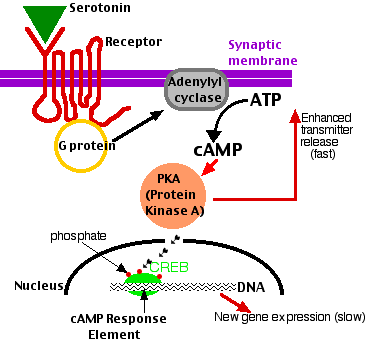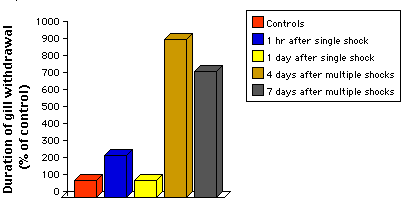
| Link to detailed discussion of G proteins. |
| Index to this page |
As its name suggests, this only lasts for a short period. It involves an increase in the efficiency with which nerve impulses pass across synapses. It does not require any protein synthesis or remodeling of the synapse.
This lasts for a long period. It involves the formation of new synaptic connections. These require new gene expression; that is, gene transcription and protein synthesis (translation).
Sensitization is an increase in the response to an innocuous stimulus when that stimulus occurs after a punishing stimulus.
An example:

When the siphon of Aplysia is gently touched, the animal withdraws its gill for a brief period. However, if preceded by an electrical shock to its tail, the same gentle touch to the siphon will elicit a longer period of withdrawal.
The sensitization response to a single shock (blue bar) dies out after about an hour, and returns to baseline after a day (yellow). So it is an example of short-term memory.
However, it the animal is sensitized with multiple shocks given over several days, its subsequent response to a gentle touch on the siphon is
These findings are the work of Eric R. Kandel (who was awarded a Nobel Prize in 2000) and his associates. Over the years, they have worked out the neural circuitry that the sea slug uses in this response.
 Withdrawal of the gill requires a two-neuron connection:
Withdrawal of the gill requires a two-neuron connection:

| Link to detailed discussion of G proteins. |
Applying another neurotransmitter, a peptide containing 4 amino acids called FMRFa (for Phe [F], Met [M], Arg [R], Phe-NH2) [Link to table of the abbreviations for the amino acids] to these in vitro preparations produces an opposite effect from facilitation — the synapses become less responsive.
Long-term depression also requires changes in gene expression. A different CREB, CREB-2, displaces CREB-1 from the cAMP response elements. Not only is the positive signal, CREB-1, removed, but CREB-2 actively shuts down the promoters by recruiting a histone deacetylase (HDAC) to remove acetyl groups from the nearby histones, thus preventing RNA polymerase from beginning gene transcription. [More]
Long-term depression also occurs in preparations of mouse brain. [Link]These responses of Aplysia are examples of implicit memory (also called procedural memory).
They involve changes in the efficiency with which motor activities of the body are carried out in response to a stimulus.
The development of simple conditioned responses and trial-and-error learning in other animals are examples of implicit memory.The cerebellum plays a crucial role in implicit memory in both mice and humans.
Explicit memory (also known as declarative memory) involves recall of objects, events, etc. outside the animal's body.
An example:

If a mouse is placed in a pool of murky water, it will swim about until it finds a hidden platform to climb out on. With repetition, the mouse soon learns to locate the platform more quickly. Presumably it does so with the aid of visual cues placed around the perimeter of the pool because it cannot see or smell the platform itself.
Explicit memory is also acquired in a short-term process followed by a long-term process.
In mice (and humans) it requires the functioning of the hippocampus.
| Link to a discussion of long-term potentiation (LTP) |
What happens when a long-term memory is recalled?
One possibility is that the stored memory remains unchanged — ready to be recalled again and again as needed (rather like a stored computer file that is copied into RAM as needed).
But this may not be what happens. There is some evidence that the very act of recalling a stored memory erases it from storage and to preserve it, it must be stored anew (rather as if a "SAVE" of an unchanged computer file actually replaced the original just as a "SAVE AS" with the same name does).
This phenomenon has been named reconsolidation.
Reconsolidation, like the original long-term storage of a memory, requires gene expression:Some of the genes needed for consolidation — CREB, for example — are the same as those needed for the original storage of the memory.
But others may be unique to the reconsolidation process. One of these is the gene — Zif268 — encoding a transcription factor that is active in the hippocampus — especially in the CA1 neurons used in Long-Term Potentiation (LTP) — where long-term memories are stored.A study (Lee, et al, Science, 7 May 2004), using rats, provides strong evidence for the need for reconsolidation of recalled memories.
Their assay was a conditioned response withAll rats were conditioned by placing them in a chamber and giving them a single shock to their feet (the US).
24 hours later (Test 1), the rats were placed in the same chamber (the CS), but not given a shock (the US). If their long-term memory was not impaired, they froze (the CR). No matter what the treatment, all the rats froze when tested 3 hours after conditioning showing no effect on their short-term memory.
Different groups of rats wereAfter another 24 hours, the rats were tested again (Test 2) by placing them in the same chamber (again, no shock). As the table shows, any treatment that impaired gene expression in the hippocampus caused the recalled memory to be lost between the first test and the second. But if they were not given the first test, then even though Zif268 expression had been blocked, their memory was unimpaired on the second test (bottom row).
| Treatment before Test 1 |
Test 1 (24 hours after CS) |
Treatment after Test 1 |
Test 2 (48 hours after CS) |
Conclusion |
| none | freezing | actinomycin D (blocks all gene transcription) |
NO freezing – original long-term memory lost |
reconsolidation requires gene transcription |
| none | freezing | anisomycin (blocks all mRNA translation) |
NO freezing – original long-term memory lost |
reconsolidation requires mRNA translation |
| none | freezing | sham injection | freezing – long-term memory still intact | control |
| Zif268 ODN (blocks Zif268 expression in the hippocampus) |
freezing | none | NO freezing – original long-term memory lost |
Blocking Zif268 expression does not hinder recall in first test but does block reconsolidation |
| sham injection in hippocampus | freezing | none | freezing – long-term memory still intact | control |
| Zif268 ODN in hippocampus |
NOT DONE | none | freezing – long-term memory still intact | rat doesn't lose a memory that was not recalled |
Much research remains to be done on reconsolidation. But if the phenomenon turns out to be a general one, it may shed light on the frequent failure of humans to recall correctly events that are repeatedly dredged up from the past ("false memories").
| Welcome&Next Search |